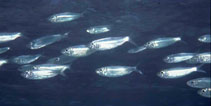| Family: |
Dorosomatidae (Gizzard shads and sardinellas) |
| Max. size: |
22 cm TL (male/unsexed) |
| Environment: |
reef-associated; marine; depth range 0 - 50 m |
| Distribution: |
Western Atlantic: Bermuda, Florida (USA), Bahamas, Caribbean, Guianas (but no records to the south of this; no Brazilian specimens in the extensive collections of the Museu de Zoologia, Sao Paulo, Brazil). |
| Diagnosis: |
Dorsal spines (total): 0-0; Dorsal soft rays (total): 13-21; Anal spines: 0-0; Anal soft rays: 12-23. Tooth plate on tongue and tooth plate behind it (basihyal and basibranchial tooth plates) very narrow, their width about 10 times in combined length, the basihyal tooth plate not bulging in front. Scales thin, loosely attached, easily shed. Tips of anterior dorsal fin rays dark. Reddish or orange spot behind upper end of gill (Ref. 26938). Body slender, with evenly curved upper and lower profiles (Ref. 7251). |
| Biology: |
Occur in coastal waters, usually along the shoreline (Ref. 9710) and over clear coral reefs (Ref. 5217). May form large schools in beaches, mainly over Thalassia beds (Ref. 5217). Often in polluted areas (Ref. 9710). |
| IUCN Red List Status: |
Least Concern (LC); Date assessed: 23 August 2012 Ref. (130435)
|
| Threat to humans: |
venomous |
Source and more info: www.fishbase.org. For personal, classroom, and other internal use only. Not for publication.

